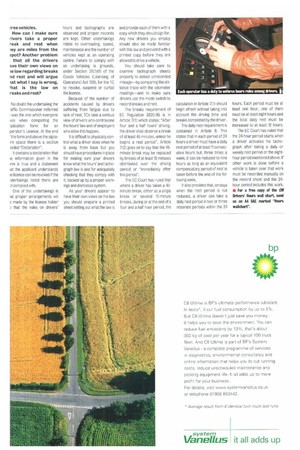REST ESSENTIAL
Page 38

Page 39

If you've noticed an error in this article please click here to report it so we can fix it.
• I operate vehicles c long-distance work Britain and had appear before Traffic Commissioni after a check on tactic graphs showed that dr vers were not takir enough breaks and res He said I had not con plied with an undertal ing given when I applie for the 0-licence and cut my licence down 1:
wee vehicles.
How can I make sure rivers take a proper reek and rest when ley are miles from the mot? Another problem that all the drivers ave their own views an le law regarding breaks rid rest and will argue tat what I say is wrong. !hat is the law on reeks and rest?
No doubt the undertaking the 'elle Commissioner referred ■ was the one which everyone ves when completing the )plication form for an perator's Licence. At the end the form and above the signaire space there is a section laded "Declaration".
It contains a declaration that le information given in the irm is true and a statement at the applicant understands le licence can be revoked if the ldertakings listed there are at compiled with.
One of the undertakings is at proper arrangements will e made by the licence holder o that the rules on drivers' hours and tachographs are observed and proper records are kept. Other undertakings relate to overloading, speed, maintenance and the number of vehicles kept at an operating centre. Failure to comply with an undertaking is grounds, under Section 26(1)(f) of the Goods Vehicles (Licensing of Operators) Act 1995, for the TC to revoke, suspend or curtail the licence.
Because of the number of accidents caused by drivers suffering from fatigue due to lack of rest, TCs take a serious view of drivers who contravene the hours law and of employers who allow it to happen.
It is dfnoult to physically control what a driver does when he is away from base but you should have procedures in place for making sure your drivers know what the hours' and tachograph law is and for adequately checking that they comply with it, backed up by a proper warnings and dismissals system.
As your drivers appear to have their own views on the law you should prepare a printed sheet setting out what the law is and provide each of them with a copy which they should sign for. Any new drivers you employ should also be made familiar with this law and provided with a printed copy before they are allowed to drive a vehicle.
You should take care to examine tachograph sheets properly to detect unrecorded mileage—by comparing the distance trace with the odometer readings—and to make sure drivers use the mode switch to record breaks and rest.
The breaks requirement of EC Regulation 3820/85 is in Article 7(1) which states: "After four and a half hours' driving, the driver shall observe a break of at least 45 minutes, unless he begins a rest period'. Article 7(2) goes on to say that the 45minute break may be replaced by breaks of at least 15 minutes distributed over the driving period or "immediately after this period".
The EC Court has ruled that where a driver has taken a 45minute break, either as a single break or several 15-minute breaks, during or at the end of a four and a half hour period, the
calculation in Article 7(1) should begin afresh without taking into account the driving time and breaks completed by the driver.
The daily rest requirement is contained in Article 8, This states that in each period of 24 hours a driver must have a daily rest period of at least 11 consecutive hours but, three times a week, it can be reduced to nine hours as long as an equivalent compensatory period of rest is taken before the end of the following week.
It also provides that, on days when the rest period is not reduced, a driver can take a daily rest period in two or three separate periods within the 24 hours. Each period must be at least one hour, one of them must be at least eight hours and the total daily rest must be increased to at least 12 hours.
The EC Court has ruled that the 24-hour period starts when a driver activates his tachograph after taking a daily or weekly rest period or the eighthour period mentioned above. If other work is done before a vehicle is taken over that work must be recorded manually on the record sheet and the 24hour period includes this work.
• For a free copy of the CM Drivers' Hours wall chart, send us an Ad SE marked "Hours walichart".




















































































































































